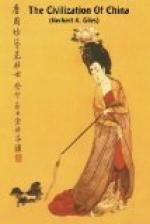The emperor was a warm patron of literature, and succeeded in bringing about the achievement of the most gigantic literary task that the world has ever seen. He employed a huge staff of scholars to compile an encyclopaedia which should contain within the compass of a single work all that had ever been written in the four departments of (1) the Confucian Canon, (2) history, (3) philosophy, and (4) general literature, including astronomy, geography, cosmogony, medicine, divination, Buddhism, Taoism, handicrafts and arts. The completed work, over which a small army of scholars—more than two thousand in all—had spent five years, ran to no fewer than 22,877 sections, to which must be added an index occupying 60 sections. The whole was bound up (Chinese style) in 11,000 volumes, averaging over half-an-inch in thickness, and measuring one foot eight inches in length by one foot in breadth. Thus, if all these were laid flat one upon another, the column so formed would rise considerably higher than the very top of St. Paul’s. Further, each section contains about twenty leaves, making a total of 917,480 pages for the whole work, with a grand total of 366,000,000 words. Taking 100 Chinese words as the equivalent of 130 English, due to the greater condensation of Chinese literary style, it will be found that even the mighty river of the Encyclopedia Britannica “shrinks to a rill” when compared with this overwhelming specimen of Chinese industry.
It was never printed; even a Chinese emperor, and enthusiastic patron of literature to boot, recoiled before the enormous cost of cutting such a work on blocks. It was however transcribed for printing, and there appear to have been at one time three copies in existence. Two of these perished at Nanking with the downfall of the dynasty in 1644, and the third was in great part destroyed in Peking during the siege of the Legations in 1900. Odd volumes have been preserved, and bear ample witness to the extraordinary character of the achievement.
This emperor was an ardent Buddhist, and the priests of that religion were raised to high positions and exerted considerable influence at court. In times of famine there were loud complaints that some ten thousand priests were living comfortably at Peking, while the people of several provinces were reduced to eating bark and grass.
The porcelain of the Ming dynasty is famous all over the world. Early in the sixteenth century a great impetus was given to the art, owing to the extravagant patronage of the court, which was not allowed to pass without openly expressed remonstrance. The practice of the pictorial art was very widely extended, and the list of Ming painters is endless, containing as it does over twelve hundred names, some few of which stand for a high level of success.




